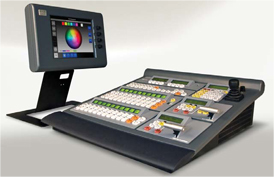A Seamless Transition

Top Notch Presentations Maximize The Power Of HD Seamless Switchers
Digital signage is not the only application that is forcing AV contractors to start learning some tricks from the broadcast industry. As anyone who has ever specified a large-scale church installation will testify, the business of presenting, recording, and replaying multimedia events is becoming more like the world of television every day. The big difference is that while your local TV station is staffed by trained professionals, your local place of worship is trying to do a similar job with a team of well-intentioned but often inexperienced volunteers.
So the challenge for contractors who supply systems to these volunteer broadcasters, and the manufacturers who design products for them, is to keep things simple and easy to operate without sacrificing quality or functionality. Nowhere in the technology chain is this more true than the seamless or production switcher, the box that enables end users to sequentially project different video sources onto their screens without having to worry about their varying formats, resolutions, or aspect ratios.
The manufacturer to first coin the phrase ‘seamless switching’ (back in 1999) was Analog Way. Today Benoit Lamy, the company’s sales manager for the southern U.S. and Canada, said the need for the switching from one image to the next to be invisible has never been more acute. “People want true seamless switching between every source they have,” Lamy observed. “They don’t want to fade to black and they don’t want any delay in the processing, which can lead to strobe effects or other artifacts. And above all, there must be no latency.”
Chris Merrill, product manager for live systems at Thomson Grass Valley, which builds production switching capabilities into its Indigo AV mixer product line, concurred: “It is essential that the switching is not seen by the audience. You don’t want any glitches or pauses as you switch from one source to another, because that draws attention to the technology. And sync is a huge issue. If a church congregation can see the drumsticks beating on the screen but they’re out of sync with what’s on the stage, then that is just not going to work.”
Barco FSN Series likely to be in HD as SD, with the increasing affordability of HD-SDI video cameras—which are now a third of the price that they once were, according to Lamy—being a major driver here. But while a broadcast TV facility might have the luxury of deploying an all-HD workflow, most pro-AV facilities do not, and for good reason.
“In the broadcast world, most of your content is pre-arranged and configured way, way upstream,” Merrill said. “But at a corporate event, for example, you might have some HD content, but you might also have someone say: ‘Here’s the latest message from the CEO. He just recorded it. We can get it from YouTube!” And you need to be able to incorporate that. That’s why you need to have production switchers that can accommodate everything from SD computer graphics to ‘beyond HD’ full-motion video.”
A daily selection of the top stories for AV integrators, resellers and consultants. Sign up below.
This is not just a question of connectivity. Lamy stresses the need for HD seamless switchers to offer an ever broader range of effects, as end users strive for ever more creative ways of blending their disparate source material into a coherent and exciting AV experience. “People want to make the transition from 4:3 to 16:9 in new ways. They’re asking us for soft-edge blending, so that they can take their computer images and then lay the camera feed on top. They also want lumakey or chromakey so that they can add text, and picture-inpicture is as popular as ever.”
Consultants and integrators may soon find the level of the clients’ sophistication increasing even further. Merrill foresees a time when the volunteers of today become as capable and as tech-savvy as the broadcasters themselves. “YouTube is training a whole new generation of production directors,” he noted. “When you go into a corporate meeting now, you don’t expect somebody to just stand and talk for 45 minutes. You expect a presentation and you expect some video content. And we see that trend continuing. We used to write letters—now we make video!”
